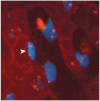Naturally acquired microchimerism
- PMID: 19924635
- PMCID: PMC2887685
- DOI: 10.1387/ijdb.082767hg
Naturally acquired microchimerism
Abstract
Bi-directional transplacental trafficking occurs routinely during the course of normal pregnancy, from fetus to mother and from mother to fetus. In addition to a variety of cell-free substances, it is now well recognized that some cells are also exchanged. Microchimerism refers to a small number of cells (or DNA) harbored by one individual that originated in a genetically different individual. While microchimerism can be the result of iatrogenic interventions such as transplantation or transfusion, by far the most common source is naturally acquired microchimerism from maternal-fetal trafficking during pregnancy. Microchimerism is a subject of much current interest for a number of reasons. During pregnancy, fetal microchimerism can be sought from the mothers blood for the purpose of prenatal diagnosis. Moreover, studies of fetal microchimerism during pregnancy may offer insight into complications of pregnancy, such as preeclampsia, as well as insights into the pathogenesis of autoimmune diseases such as rheumatoid arthritis which usually ameliorates during pregnancy. Furthermore, it is now known that microchimerism persists decades later, both fetal microchimerism in women who have been pregnant and maternal microchimerism in her progeny. Investigation of the long-term consequences of fetal and maternal microchimerism is another exciting frontier of active study, with initial results pointing both to adverse and beneficial effects. This review will provide an overview of microchimerism during pregnancy and of current knowledge regarding long-term effects of naturally acquired fetal and maternal microchimerism.
Figures



References
-
- ABBUD FILHO M, PAVARINO-BERTELLI EC, ALVARENGA MPS, FERNANDES IMM, TOLEDO RA, TAJARA EH, SAVOLDI-BARBOSA M, GOLDMANN GH, GOLONI-BERTOLLO EM. Systemic lupus erythematosus and microchimerism in autoimmunity. Transplant Proc. 2002;34:2951–2952. - PubMed
-
- ADAMS KM, HOLMBERG LA, LEISENRING W, FEFER A, GUTHRIE KA, TYLEE TS, MCDONALD GB, BENSINGER WI, NELSON JL. Risk factors for syngeneic graft-versus-host disease after adult hematopoietic cell transplantation. Blood. 2004;104:1894–1897. - PubMed
-
- ADAMS KM, LAMBERT NC, HEIMFELD S, TYLEE TS, PANG JM, ERICKSON TD, NELSON JL. Male DNA in female donor apheresis and CD34-enriched products. Blood. 2003;102:3845–3847. - PubMed
-
- ADAMS KM, YAN Z, STEVENS AM, NELSON JL. The Changing Maternal «Self» Hypothesis: A Mechanism for Maternal Tolerance of the Fetus. Placenta. 2007;28:378–382. - PubMed
-
- AL-MUFTI R, LEES C, ALBAIGES G, HAMBLEY H, NICOLAIDES KH. Fetal cells in maternal blood of pregnancies with severe fetal growth restriction. Hum Reprod. 2000;15:218–221. - PubMed
Publication types
MeSH terms
Substances
Grants and funding
LinkOut - more resources
Full Text Sources
Other Literature Sources
Medical

